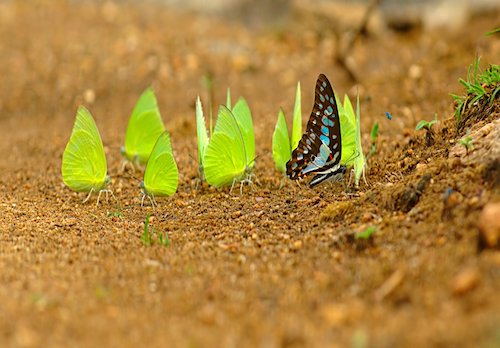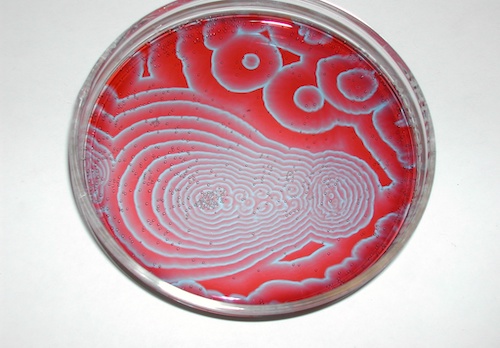Lichensong
The project uses projection mapping to illustrate a work of speculative fiction tracing the evolution of life on earth. Tracing interweaving journeys of lichen, oil, bacteria, insects and computation, I try to use the images to add viscerality and weight to the story.
produced by: George Kuhn
Introduction
I used different kinds of generative art to illustrate ideas from the story directly. Dealing with ideas from Stenger's and Prigogine's Order out of Chaos, I wanted to demonstrate simple processes where the the application of laws to randomness generates complex patterns. Pattern formation here is an emergent behaviour, driven by thermodynamics applied as selection principle. I wrote a short story exploring these themes, and chose three accompanying scenes: drifting lichen or moss, the Belousov–Zhabotinsky reaction and the swarming behaviour of insects.
Concept and background research
This project follows the emergence of complex forms from disorder. The theory is drawn mostly from Stengers and Prigogine's Order out of Chaos, where they argue that fractal uncertainty and the science of heat mean both that most dynamic systems are not integrable and that for systems to remain in equilibrium energy must be the only factor conserved in transformations. I wrote a story that tries to apply these ideas to early life on land. As lichen emerge from the sea, they are able to harvest more energy from the sun. This excess allows them to break from equilibrium. This idea is taken as a cornerstone for the speculative fiction that pre-human technology is the specialisation of organisms that creates energy differentials, letting them escape stasis and evolve. Art is a useful tool to explore this, as I found it an interesting idea for story telling, whether or not its scientifically valid. Engaging by picking a thread and tracing how it connects different organisms and situations draws on the approach used by Donna Haraway in Staying with the Trouble. The choice of subject organisms (fungi, bacteria, insects) is inspired by Sadie Plant's writing on bacterial transmission in Zeros and Ones, Lynn Margulis' What is Life? and Robert Macfarlane's Underland.
The aesthetics are influenced by generative approaches to forms seen in organic contexts, Karl Sims' reaction diffusion model being the jumping off point for the project. Jenny Holzer's rhythmic delivery of text was also an inspiration for the method of communication. While working on it I was also influenced by slow cinema, such as the work of Béla Tarr, to contrast the fast paced narrative with scenes that unfold gradually.
Technical
To fit with the theme I wanted all 3 scenes to be generative, to have rules in place and then be let go, rather than being strictly choreographed. I also wanted the scenes to increase in complexity. For the first scene I took a noise drawer as a skeleton (as a noise drawer uses mathematical models of 'natural' pseudorandomness), realising that by varying the color and opacity over various shades of green and wrapping the values it could take so that it stayed screen for the entire minute I could produce an effect somewhere between drifting lichen or psychedelic moss. For the second scene I knew that I wanted to model the Belusov-Zhabotinsky reaction, which I based on a reaction diffusion models of chemical oscillators. The final scene I initially planned to simulate the three body movement, however I didn't think I'd be able to break down the maths enough to properly construct a model in time. I then tried to construct a fake model of it by combining solar system code from class with flocking algorithm code. However, it didn't look very visually satisfying with so few bodies on screen, so I coded moth like shapes to replace the bodies and used the flocking algorithm as the final example of complex behaviour produced by law-constrained chaos. The scenes are projected onto one box; the form of the box is totally flattened in the first and last scene as the box is covered in disordered forms. In the second the box's geometry is produced by the reaction diffusion slowly spreading over it. This felt quite neat and symmetrical to me.
Future development
Natural extensions of the work are to project different stories on different sides of the box, to introduce competing accounts and more tension. The stories could have different 'energy' levels with the more fast paced passages being accompanied by scenes whose parameters have been tuned to be more chaotic (pace of word delivery could also be linked easily to the level of chaos in the scene). Existing scenes could also be combined to produce new scenes, for example the butterfly flocking and reaction diffusion scenes could be combined to create the effect of pheromones slowly diffusing and affecting flocking, creating something more akin to an ant colony. This process of combining and exchanging laws and rules across a patchwork of different conditions would be thematically consistant with the Haraway inspired research approach.
Self evaluation
Currently the scenes are very cpu intensive and as a result the framerate varies, especially once the scenes were ported to pimapper. As the story was timed and paced by framerate this causes issues where the words often appear to slow and the cuts come at the wrong time. I would consider changing the timing to work based on elapsed millis instead. I would also experiment more with more visual elements between the background images and text, this could give increased depth making the contrast between the scene that emphasises and scenes that obfuscate the cube more dramatic.
I am also a beginner at C++, if I had a better understanding of arrays, vectors and vector maths I could have saved a huge amount of time on translating code from different languages into C++, giving me more time to focus on manipulations of it.
References
Stenger and Prigogine - Order out of Chaos :
https://deterritorialinvestigations.files.wordpress.com/2015/03/ilya_prigogine_isabelle_stengers_alvin_tofflerbookfi-org.pdf
Donna Haraway - Staying with the Trouble :
https://www.jstor.org/stable/j.ctv11cw25q
Daniel Schiffman - boids : https://www.youtube.com/watch?v=mhjuuHl6qHM
Daniel Schiffman - reaction diffusion : https://www.youtube.com/watch?v=BV9ny785UNc&t=431s
Sayama noise - drawer : https://www.openprocessing.org/sketch/837659


































































